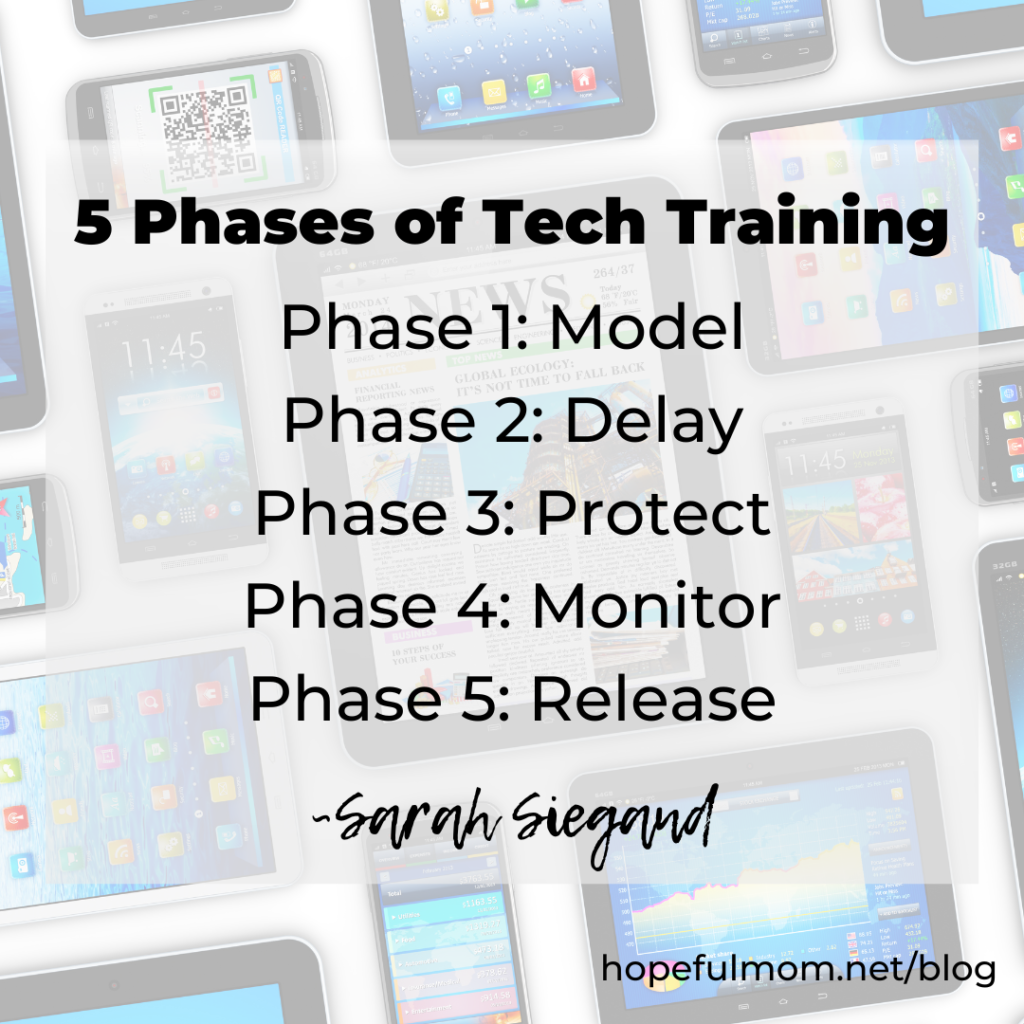I’m so excited to introduce you to my friend, Sarah Siegand. Sarah and I met through Safeguard Alliance. I love her enthusiasm and desire to help parents learn about technology. I know you will find her post on tech training informative and motivating. (She didn’t mention it in her bio, so I will . . . She wrote a book! Find it here.)
Technology isn’t going anywhere, and today’s parents need a solid strategy for how their families will either embrace or reject the influence of tech. If the goal is to raise kids who are not enslaved to technology, we must have a long and a short view of intentional strategies at every age and stage. It requires us to train them!
The following phases will help you locate where you are in the training process for each individual child or teen you’re parenting and what skills you will need to build next.
Phase 1: Model
Every parent starts here, and none of us really graduate from this stage. Our kids are watching how we use technology, as well as gleaning information about how it fits into our family’s values and priorities. When they are on the ballfield, can they catch your watchful eye, or do they see you on your phone? Is a TV always on in your house? How many new technology purchases have you made this year? Do your kids see you reading books or enjoying nature? All of these answers build what your kids understand as your relationship with technology, and consequently, how they should expect to relate to it as well.
Technology isn’t going anywhere, and today’s parents need a solid strategy for how their families will either embrace or reject the influence of tech. 5 Phases of Tech Training ~Sarah Siegand #sexpectations #healthyrelationships… Click To TweetPhase 2: Delay
We all know that kids’ brains are not fully formed until adulthood, but it’s important to also acknowledge the way brains are developing in the preteen and the teen years. Generally speaking, puberty and tech can be a dangerous combination. We encourage parents to wait as long as they can for some of the most addictive and potentially destructive kinds of technology, namely YouTube, video games, smartphones, and social media.
What kids see, they try to imitate, with little thought to the consequences. They aren’t mature enough to understand all of the danger or addiction that lies just beyond those open doors. They don’t have the discernment to sift out the good and bad influences available on technology. We think this Dove Beauty video perfectly sums up why we encourage delaying specific kinds of technology that is addictive and can easily open your kids up to dangerous content and ideas.
Phase 3: Protect
The first layer of protection is building a strong parent-child relationship and having great conversations about technology pitfalls. I use an oven mitt as a visual aid for parents—conversations are the hand inside the mitt, and automated tech boundaries are the mitt itself. Automated protections include things like time limits, parent approval for app downloads, filters on web browsing, and manual tools include things like knowing who your kids are communicating with and not allowing devices in private spaces like bedrooms. Beyond the immediate protection these measures offer, they also build an important understanding in your child that 1) they are worth protecting and 2) there is a real danger to be protected from.
Phase 4: Monitor
How is monitoring different than protecting? Protection includes closing and locking doors to certain dangers online. Monitoring doesn’t prevent your kid from accessing potential dangers, but it does give you information after the fact so you can have a conversation about what happened so they can learn.
Monitoring might include using technology tools like Bark to scan for problematic activity like bullying, sexual content, and more. Or it might be just picking up a phone and looking through things to know what your kid is up to or how much time they’ve spent on the device. The monitoring phase should be a constant flow of feedback and making adjustments. One of the greatest blessings of this phase is when you catch your kid doing things RIGHT.

Phase 5: Release
Yes, parents… one day your kid will walk out your door with a phone in their back pocket that only has whatever safety features THEY have set for themselves. It can be a scary thought no matter how much you’ve tried to pour into them. But if you work from that reality backwards, and see all the present-day tech training through the lens of this unchanging fact, you might find a renewed motivation to get after it.
Our 19-year-old is going off to college in another state in just a few months. He’s never slept with his phone in his room, so as he graduates, we’re getting ready to make that move. He’ll have the summer to adjust, realize where his biggest challenges lie, and hopefully gain some strategies. He can’t take mom and dad to the dorm room, he must learn to do this on his own.
It’s Never Too Late to Start Tech Training
No matter how old your kids are, you are bound to find something within your power presently that you can take action on to help them in this training process. If you have a 4-year-old, you have a lot of runway in front of you, and there is great hope that your child will thrive as you intentionally build these skills. If you have a 17-year-old that you wish you could get a do-over with, let me encourage you that your son or daughter is not beyond hope. As you approach the launch from your home (whenever that comes), you’ll have to be very gracious—admit what you know you didn’t do well, and talk about what tech health goals they have as a young adult and how you can support them.
JUST DO SOMETHING, even if it’s putting down your phone to read a book when you know your kids are watching. Or sponsoring a screen-free vacation. Or initiating a family bike ride. We can all do something to improve the overall health of our family in how we relate to technology.
Happy parenting!
For a more detailed look at these 5 Phases, visit Parentswhofight.com.
Remember to subscribe to Hopeful Mom below and share this post with another parent. Someone you know may need this information.
About the author

Sarah Siegand
Sarah Siegand is the mom of two teenage boys and lives in Nashville, TN with her husband of 25 years, Jesse. Sarah and Jesse founded Parents Who Fight in 2015 as a response to concerns over pornography exposure at their kids' elementary school. For the past eight years, Parents Who Fight has been coming alongside parents to train them in the pitfalls and dangers of technology and give them tools to better protect kids online. They offer workshops, personal safety consultations, and daily encouragement on social media to help families strengthen their online safety strategies. For more information, go to parentswhofight.com.



One Reply to “5 Phases of Tech Training”